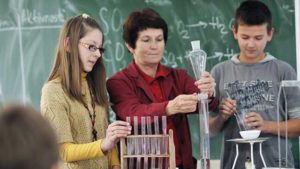Home » Commentary » Opinion » Simple solution to STEM teacher shortage
· Ideas@TheCentre
 Faced with the shortage of qualified teachers for science, technology, engineering, and maths (STEM) subjects, the federal government recently announced its intention of solving this problem — but it is a state and territory issue.
Faced with the shortage of qualified teachers for science, technology, engineering, and maths (STEM) subjects, the federal government recently announced its intention of solving this problem — but it is a state and territory issue.
Alan Finkel, Australia’s Chief Scientist, delivered an excellent speech last week extolling the importance of teaching rigorous content knowledge in STEM subjects. He identified the problem of many student arriving at university to study STEM-related degrees without the necessary foundations. Clearly, we need to improve the quality of maths and science teaching across the school system.
But it is difficult to attract science and maths graduates to the teaching profession. Approximately 20% of Years 7–10 science and maths teachers in Australia do not have any university qualification in their subjects.
One straightforward idea to encourage STEM graduates to become teachers — which CIS has been advocating for many years — is to allow differential, market-driven pay rates for teachers depending on the demand for qualified teachers in their subjects.
This isn’t like the simplistic ‘pay all teachers more’ or ‘introduce performance-based pay’ solutions.
Rather, teacher salaries should be higher or lower depending on whether there is an oversupply or undersupply of teachers in the subject. For example, if there is an oversupply of history teachers and an undersupply of science teachers, then schools should be able to pay science teachers relatively more.
While this might seem an absolute no-brainer, it is surprisingly controversial. Education unions tend to oppose differential pay rates, which helps explain why we continue to have set teacher salaries that only vary with experience and expertise, and not with subject area. As long as this is the case, it is very hard to see an end to Australia’s STEM woes.
The truth is maths, engineering, and science graduates tend to be in demand by many employers, and so they have to forgo relatively high-paying jobs to go into teaching.
Another impediment for STEM graduates becoming teachers is that they must take two years off paid work to do a Master of Teaching. Until recently, it was possible to do a one-year Graduate Diploma of Education instead.
The benefits of a Masters compared to a Diploma are arguable — and university teacher education degrees often don’t equip teaching graduates with evidence-based practices. So it is hard to argue that STEM graduates should have to do a further two years of full-time study to become qualified teachers.
Introducing differential teacher pay rates for STEM teachers won’t solve the problem overnight, but there seem to be few other viable options.
Simple solution to STEM teacher shortage